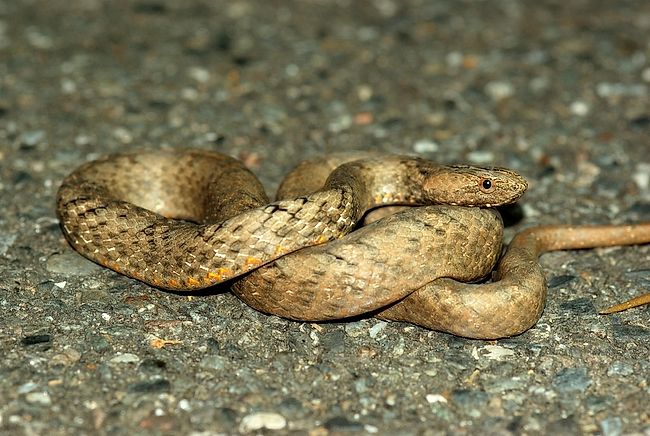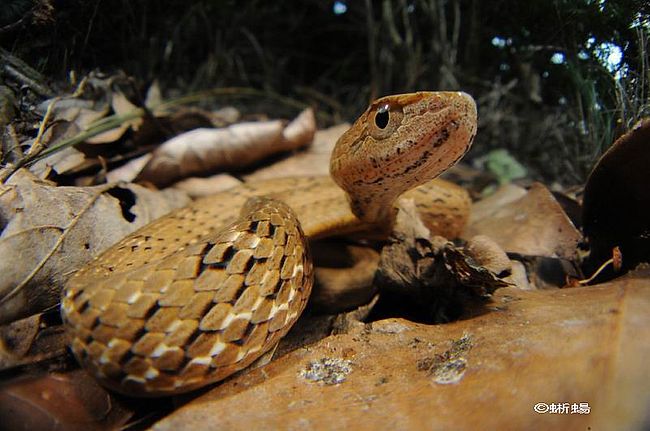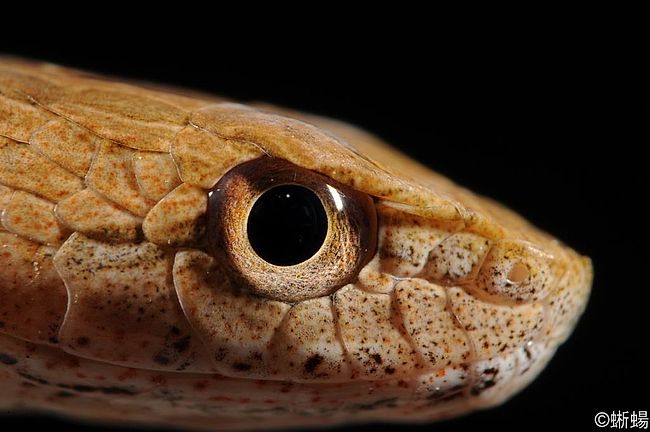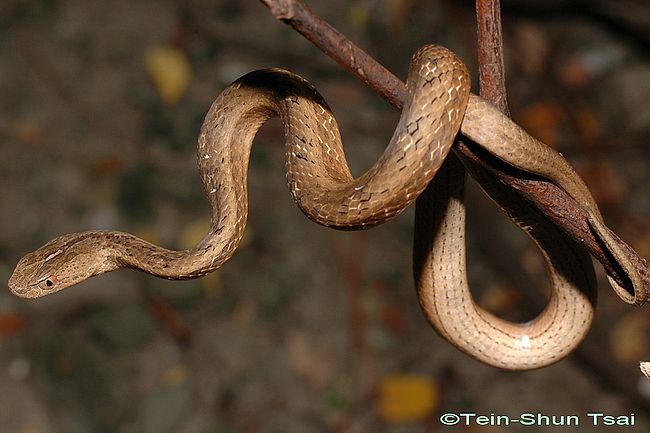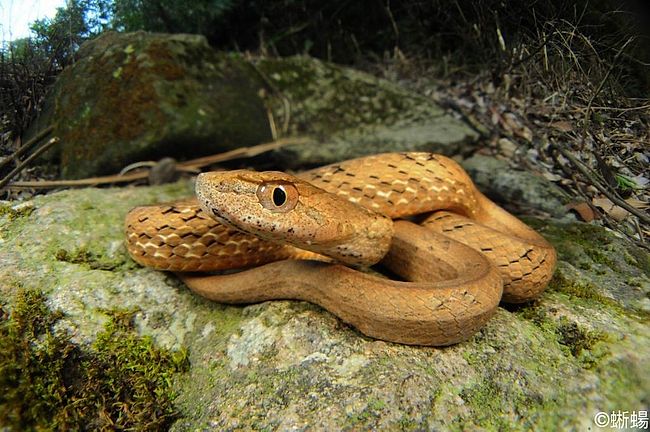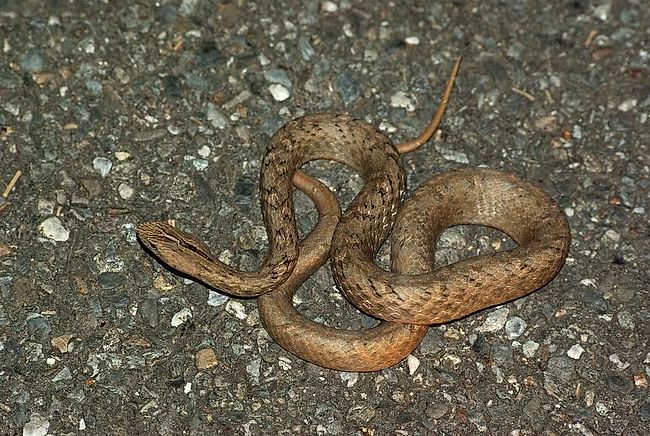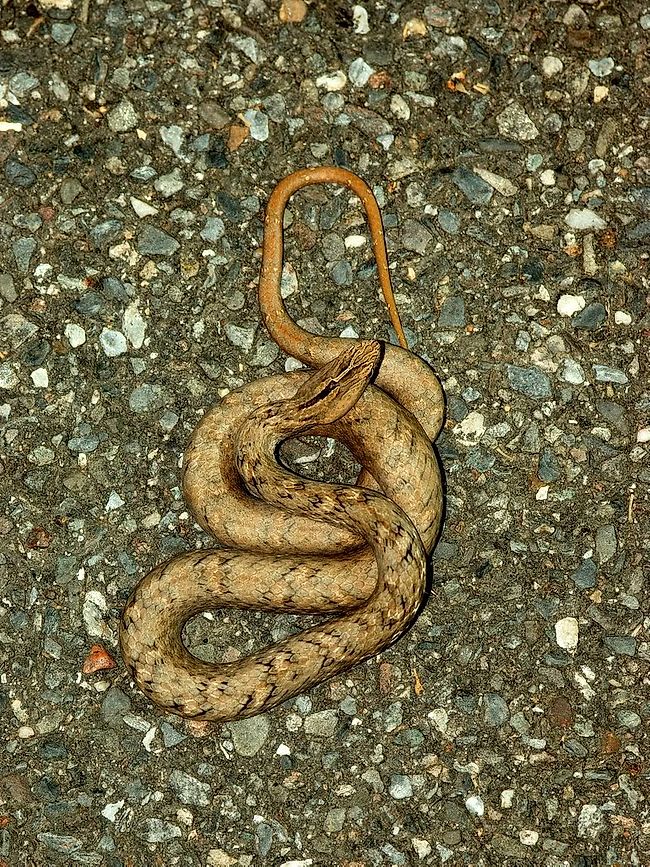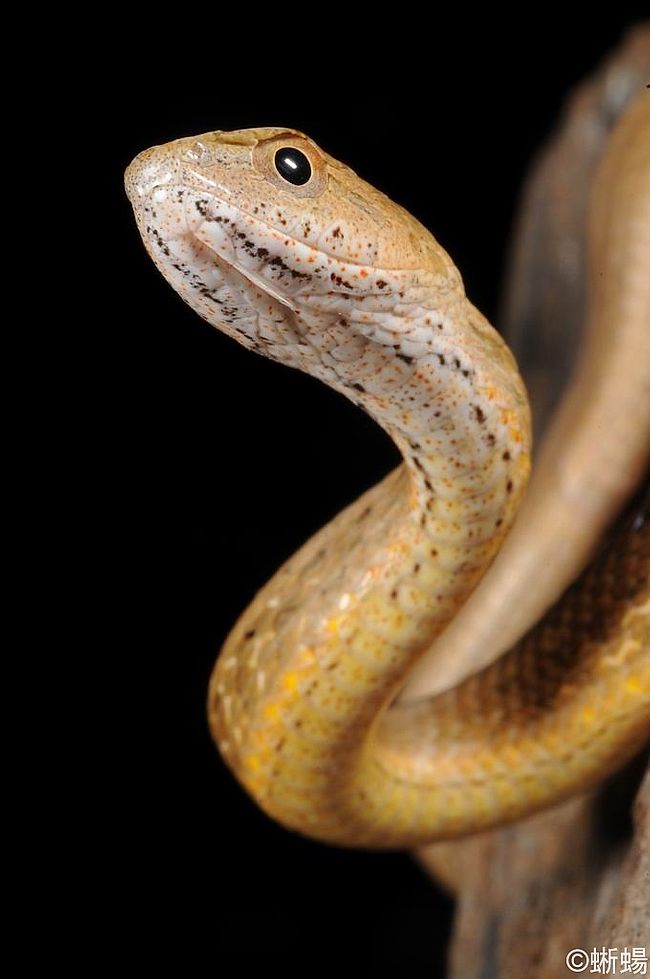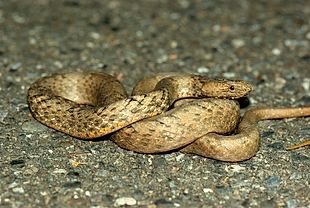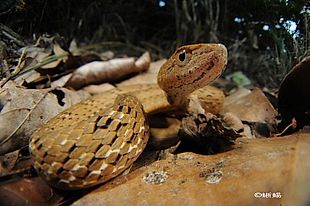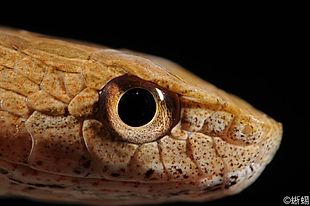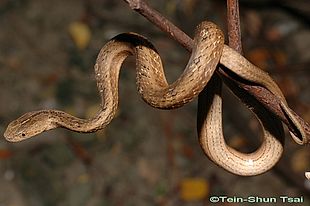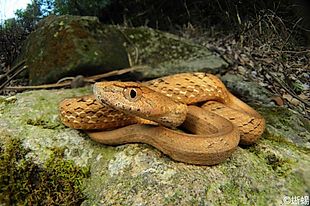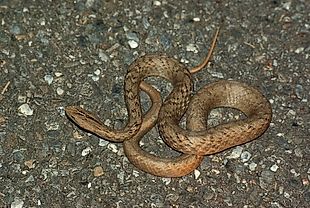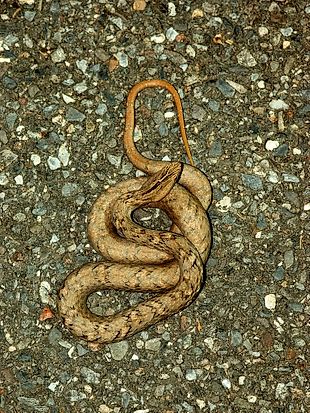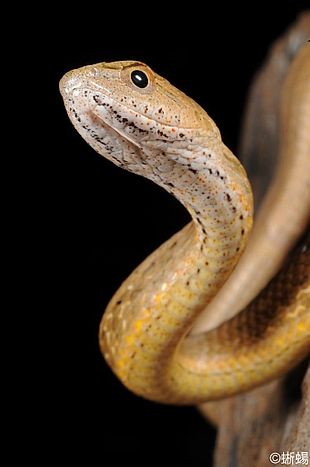Psammodynastes pulverulentus papenfussi
Mock Viper
茶 斑蛇 (cha2ban1she2)
Status: Protected (Cat. II)
Mildly venomous
Family
Colubridae, subfamily Boiginae
Max. length
65 cm
Occurrence in Taiwan
Throughout Taiwan and Orchid Island, up to 1000 m altitude. Common.
Global Distribution
The subspecies P. p. papenfussi is endemic to Taiwan.
Description
Small snake; total length up to 65 cm (less in males), but most animals are smaller. There are 13-17 (17 at mid-body) rows of scales, which are smooth but not glossy. Head is elongate oval to slightly triangular and distinct from neck; body is slender; tail is long. Eye is large; iris is medium to dark brown, dappled and flecked with light brown and pupil is broadly elliptical on vertical axis. There is a prominent angular ridge from upper eye to end of snout. Tongue is dark brown to black; teeth are long, well developed, resembling fangs in upper jaw. There are three pairs of chin plates. Upper head is light to dark brown or even chocolate with a darker, longitudinal ''Y'' whose arms extend forward onto the ridge between eye and snout, basing at the posterior margin of the parietals, and extending posteriorly along the mid-dorsal line. The supralabials are lighter in color, mottled with white, dirt yellow or black. Upper body and tail are light to dark brown or even chocolate, tinged with scattered, diffuse, deep red and/or scattered deposits of diffuse dark brown to black which is more prominent anteriorly. Ventral head is white to light gray, mottled with tan, black or gray; the deposits of black on the infralabials may form a longitudinal line. Ventral body is light gray to dark gray brown, mottled with brown or gray pigment which concentrates to form light longitudinal lines. Anal scale is entire, and subcaudals are paired.
Biology & Ecology
The triangular head that is clearly distinct from the neck is very characteristic for this cathemeral
(diurnal and nocturnal), opistoglyphous (= rear-fanged, see footnote (1)) species. The shape of the head is
the reason this snake is often confused with pitvipers, and also the reason for its common English name.
Many members of the family Colubridae that are considered venomous are essentially harmless to humans,
because they either have small venom glands, relatively weak venom, or an inefficient system for venom delivery.
The Mock viper's venom is actually much less powerful and less harmful to humans than that of true vipers. The
teeth are adapted to feeding on heavy-scaled vertebrates, like skinks, and other snakes, but P. p. papenfussi
also eats frogs.
This snake displays a very broad coloration range; some individuals are very dark
chocolate-colored, others are reddish-brown, gray, yellow, or almost black. Some have
hardly any head or body patterns, while others specimens show small spots or stripes.
P. p. papenfussi is found in plains, including marshes, swamps and rice paddies, as
well as dry and wet forests. It almost never occurs close to human settlements. This
species is terrestrial, but may also be found in low bushes.
This snake is ovoviviparous and produces litters of 3 - 10 live young several times
a year. Juveniles are 15 to 18 cm long and resemble adults.
It is an irritable species that will form defensive coils and strike in viper-like
fashion when threatened. Its bite is strong and the animal will clamp down hard when
biting.
The dentures of this species are "unusual, because it has grooved rear fangs and front
fangs with shallow grooves. This is the only snake known to have fangs in both positions
on the maxillary. Harry Greene suggested the front fangs are used to snare hard-scaled,
slippery skinks (a group of lizards with a bony plate under each very smooth scale).
When Kate Jackson and Thomas Fritts looked at the fangs, however, they found grooves
in the front fangs. These grooves were not the deep folds with rounded edges that run
the length of the fang as in some rear fanged species. These teeth contained multiple
shallow grooves that could allow liquids from the mouth to enter a wound, increase the
ability of the fang to penetrate the prey, or facilitate pulling
the teeth out of the prey." (John C. Murphy, Secrets of the Snake Charmer, 2010)
As with most other rear-fanged species, not much is known about the Mock Viper's venom.
There are no reports of deaths or severe bites, but there may be swelling, redness and aching
muscles in the bite area. The venom might contain some kind of anti-coagulant in the venom,
because the bite wounds tend to bleed profusely.
Etymology
Psammodynastes : "The generic name is derived from the Greek psammos = sand, and
dynastes = ruler. These snakes, which do not live in sandy countries, were first
placed in the genus Psammophis, a group living mainly in sandy, arid areas that
could account for the unsuitable first part of the present name." (A Field Guide to
the Snakes of Borneo, Stuebing & Inger, 1999);
pulverulentus: "comes from the Latin words pulveris = dusty, and lentus = full of, referring to the dusky coloration." (ibid.)
papenfussi : in honor of American herpetologist Theodore J. Papenfuss.
The Chinese name 茶斑蛇 (cha2ban1she2) literally means "tea-striped snake", alluding to its coloration and pattern.
Footnotes
(1) "Opisthoglyphous snakes are similar to aglyphous (fangless) snakes, but possess weak venom,
which is injected by means of a pair of enlarged teeth at the back of the maxillae (upper jaw).
These "fangs" typically point backwards rather than straight down, possess a groove which channels
venom into the prey, and are located roughly halfway back in the mouth, which has led to the
vernacular name of "rear-fanged snakes". (Source)
Further Info








